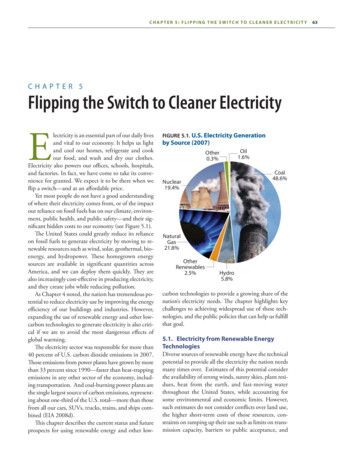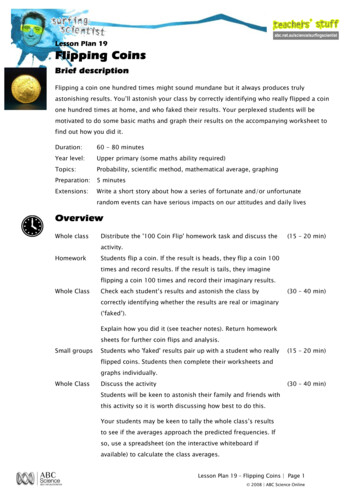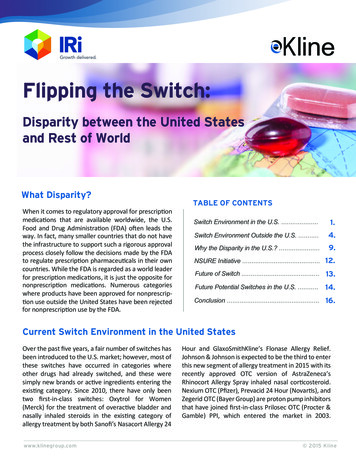
Transcription
Flipping the Switchfor a Cleaner GridISSUE BRIEFUsing Time-Varying Rates to BoostRenewables and Save MoneyHIGHLIGHTSTo limit the scale and scope of futureclimate impacts, we must accelerate ourshift away from an electricity systemdominated by fossil fuels toward onepowered by clean, renewable resources. Oneway to facilitate this effort is to encouragedemand flexibility, where we shift our use ofelectricity to align with times when it iscleanest and most efficient for the grid.Utilities can help encourage thesebeneficial demand shifts through the useof time-varying electricity prices, whichsignal to consumers better and worsetimes to use electricity by moving priceslower and higher accordingly. Whencarefully designed and communicated, thisrelatively straightforward solution hasthe potential to yield economic andWhen it comes to electricity, most of us use it whenever we want, however wewant, because we have no reason not to: the majority of households in the UnitedStates pay “flat” or “average” electricity rates that stay constant over the courseof the day and often the year. But these uniform rates mask the fact that our electricity grid is far from static. Consumer demand varies from hour to hour, day today, and season to season—and so does the mix of generators providing electricityto meet that shifting demand. This means that electricity is cleaner and cheaperto provide at some times, and more expensive and heavily polluting at others.By obscuring the true costs of electricity consumption, flat rates have contributed to our electricity system becoming more expensive and less efficient. Forexample, peaks in demand are met largely by relying on fossil-fuel power plants,some of which sit idle most of the year even though customers pay for their construction and maintenance. And, because peak consumption costs contribute toutilities’ future rates, these demand spikes can result in higher electricity costs forconsumers over time. Lastly, as we build out our clean energy resources, flat ratesleave no way to incentivize customers to shift consumption toward times of theday when clean energy resources are most plentiful—a missed opportunity tocapitalize on abundant zero-emission electricity.A critical step in propelling us toward a lower-carbon, lower-cost electricitysystem is pulling back the curtain on the dynamic costs of production and consumption. One of the simplest ways to do this is also one of the most promising:using price signals to indicate when electricity is cleaner and less expensive, andshaping and shifting electricity use accordingly. Time-varying electricity rates—environmental dividends for all. CAISOElectricity grid operators must constantly balance consumer demand with electricity supply to maintainreliability and avoid blackouts. We can achieve significant environmental and economic benefits by aligningconsumer demand with periods of high renewable energy generation; time-varying rates are one of the bestways to facilitate this shift.
which move higher or lower over the course of the day, week,and/or season in accordance with true system costs—can savemoney and better match consumer demand with our supplyof clean energy resources (see Figure 1). Changing how andwhen we use the grid enables and empowers everyday consumers—and the innovators who serve them—to play a directrole in making the whole system run cleaner and more efficiently, and in making it easier for renewables to come andstay online.Time-varying rates differin their structure andlevel of complexity, butall use changes in price toincentivize more efficientelectricity consumption.How Price Signals Can Shape Electricity UseTime-varying rates differ in their structure and level ofcomplexity, but all use changes in price to incentivize moreefficient electricity consumption. Here, “efficient” electricityconsumption does not simply mean using less, though anincrease in overall energy efficiency—and thus a decreasein overall energy use—does benefit the system. Instead, theconcept also considers cost and pollution reductions thatresult from shifting electricity consumption away fromFigure 1.periods when we have to call upon inefficient and heavilypolluting generation.The most common forms of time-varying rates aredescribed below (and illustrated in Figure 2). The diverseoptions give utilities flexibility in choosing the rate structurethat best incentivizes the shifts required by their specificgrid needs.Peak Electricity Demand and Clean Energy Supply Are Mismatched100%Hourly Value as% of Daily Maximum90%80%70%60%50%40%30%20%10%0%12 a.m.4 a.m.8 a.m.12 p.m.4 p.m.8 p.m.12 a.m.Time of DaySystem LoadSolar PV GenerationWind GenerationToday, peak electricity demand is not usually aligned with peak clean energy supply. By incentivizing customers to shift electricity useto periods of greatest clean energy resource availability—such as during midday hours when solar production is highest and in the lateevening hours when the wind blows hardest—time-varying rate designs can result in a cleaner, more efficient electric power system.NOTE: System load curves and resource generation curves can change across days, seasons, and regions. This figure displays one resource scenario based on anillustrative July 2016 day for the California ISO.SOURCES: CAISO n.d.a, CAISO n.d.b.2union of concerned scientists
Real-Time Pricing: This highly dynamic rate structureadjusts the prices customers see in parallel with thebroader fluctuations in electricity system costs. Ratescan vary in increments as small as five minutes, and aslarge as one or more hours. Typically, real-time pricingrequires “smart” meters, which communicate consumption data to utilities at a set interval, as well as someform of in-home device to convey up-to-date pricesto customers and, in some cases, automatically controlselect household appliances (see next section for details).This type of rate provides consumers with the greatestopportunity to shift their usage to best match the availability of clean and low-cost power.Electricity Rate(cents per kilowatt-hour)Typical Flat RateTime-of-Use Rate12 a.m.6 a.m.12 p.m.6 p.m.12 a.m.Electricity Rateb. Critical Peak PricingTypical Flat RatePeak Event RateNon-Peak Rate(cents per kilowatt-hour)C ritical Peak Pricing: This rate change is invoked justa few times a year, when demand is at its highest, to avoidcalling into service the most expensive, least efficientgenerators. In a critical peak pricing program, utilitiesnotify customers about 5 to 10 times per year, typicallywith a day’s notice, that a set number of hours the nextday will be considered a peak event, and that rates duringthose hours will jump accordingly. In return for deferring or decreasing electricity use during those select windows, customers receive a lower rate the rest of the year.A variation of critical peak pricing is “peak-time rebates,”in which utilities provide rebates for reduced electricityuse on peak event days, as opposed to charging higherrates over the same periods. In this variation, customersare not exposed to the risks of higher rates, but also donot receive lower rates over the rest of the year.Time-Varying Electricity Rate Designsa. Time-of-Use Pricing12 a.m.6 a.m.12 p.m.6 p.m.12 a.m.c. Real-Time PricingElectricity Rate Figure 2.Typical Flat RateReal-Time Rate(cents per kilowatt-hour) Time-of-Use Pricing: These rates, with predictableon-peak and off-peak periods, encourage changes inthe overall use of electricity over the course of the day.During hours when system demand is typically at itshighest, prices are, too; when demand is traditionallylower, prices are reduced. Time-of-use rates arecommonly established as two- or three-tiered systemswith preset prices. In a three-tiered system, for example,utilities may charge the highest price during the earlyevening, a moderate price during the daytime and laterevening hours, and the lowest rate overnight through theearly morning. In most time-of-use programs, weekendsand holidays are subject to a lower rate across all hours.In regions where electricity demand is tied to seasonal patterns, such as higher-than-average demand inthe summer because of air conditioning or the winterbecause of electric heating, pricing tiers can be tied to theseasons to reduce peak strain on the electricity system. 12 a.m.6 a.m.12 p.m.6 p.m.12 a.m.a. Time-of-use pricing employs preset rates that repeat each day toencourage shifts in electricity use away from peak hours. b. Criticalpeak pricing specifically targets the 5 to 10 days when electricity useis highest by charging very high rates during peak hours on thosefew event days, and lower flat rates for the remainder of the year.c. Real-time pricing approximates the actual cost of consumptionover the course of the day.Note: The above rates are illustrative only; actual scale and timing of rates willdepend on the utility region’s supply mix and demand patterns.Flipping the Switch for a Cleaner Grid3
A key advantage of time-varying prices is that theactual structure of the rates can evolve over time in responseto changing electricity infrastructure and resource mixes. Asmore solar resources come online, for example, it could makesense for customers to shift even more of their electricityuse to the middle of the day when solar power generationis most abundant. The more we are able to take advantageof clean energy resources when they are available, the lessthat must be invested in costly fossil fuel–based peakinggenerators and related fossil-fuel infrastructure. Interruptible: Certain energy uses (e.g., refrigeratorand air-conditioner compressor cycling, water heater)can be temporarily paused or turned down to respond tofluctuating supply costs. These loads are typically pausedor adjusted for just minutes, so their interruption has noadverse impact on appliance performance or consumercomfort. Interruptible loads can be managed to occurindependently from one another, or aggregated to occurat the same time, depending on the load-reduction goal,household usage patterns, and the amount of coordinationpossible. Device-to-grid and device-to-device communications enable and optimize this form of control,respectively. Energy storage: Tank water heaters and electric vehiclebatteries are just two examples of energy storage systemsin which the timing of actual energy use (i.e., hot water,driving) is different from when electricity is taken fromthe grid. These types of systems can best be thought ofas a form of intraday battery. They are well-suited forshifting loads that otherwise would be occurring duringpeak hours. New energy storage technologies are rapidlyevolving, from simple timers to advanced device-to-gridcommunications that can not only optimize and automate appliance performance, but also provide ancillaryservices such as helping to maintain reliability andstability in the event of a downed power line or powerplant outage.How Households Can Shift DemandFor time-varying prices to work, consumers must be ableto change their electricity use in response to prices movinghigher and lower. Some changes are as simple as choosing torun a dishwasher at an off-peak time, or selecting a delayedstart option on an appliance (if available). Other methodsare more technologically involved; a fully grid-connectedhome could automatically—and imperceptibly—adjustconsumption in response to grid signals.Demand flexibility controls fall into three maincategories:Discretionary: Many home appliances can be operatedwhenever the consumer chooses (e.g., dishwasher, clothesdryer). This type of demand control can be harnessedunder any type of time-varying pricing strategy, fromdelaying use of a dishwasher for a couple of hours during apeak period event (critical peak pricing), to recognizingthat wash cycles will be consistently cheaper if runduring off-peak hours (time-of-use pricing). No additional technologies are required for this form of control.Of course, not all electricity consumers are alike. Householdsvary widely in terms of the appliances that are installed, howefficient they are, and how and when homeowners use them.Further, there are significant geographic differences in energyrequired for heating, cooling, and water heating, which are iStockphoto.com/ABBPhoto (left); General Motors (right) Residential customers can respond to time-varying rates in a range of ways, from low-tech (e.g., delaying the start time of a dishwasher) to high-tech (e.g., chargingan electric vehicle through an integrated solar photovoltaic system).4union of concerned scientists
Designing a Beneficial Time-Varying PricingProgramSome utilities have tried implementing time-varying ratesfor residential customers in the past, but for a long time, theeconomics were unsupportive. The technology required to tievolume of consumption with time of consumption was eitherbeyond what was commercially available, or too expensiveto justify for small, residential loads. As an interim step, someutilities have deployed inclining block rates, or rates thatincrease for each incremental block of electricity consumedabove some baseline. This approach recognizes the increasedcosts of serving higher loads, but does not differentiate costsacross times of use. However, the increasingly wide-scaledeployment of smart meters and the growing availability ofhome energy management systems, in addition to increasingenergy efficiency and renewable energy requirements inmany states, are beginning to result in time-varying pricingprograms making technical and economic sense.While updating our electricity rates to recognize andreward demand flexibility will result in population-wideeconomic and environmental benefits, it is critical that thesesame rates preserve individuals’ access to affordable, reliablepower. Here, we outline the key tenets of designing a beneficial and equitable time-varying pricing program.Successful deployment requires customeroutreach and education.Across the board, successful program implementation andcustomer buy-in relies on clearly and transparently communicating all aspects of the program to customers. This includescommunicating the intent to change from flat to time-varyingrates and the implications of that change, and outlining thevarious ways in which customers can modify their everydaybehaviors to maximize savings under the new program. Evenwhen customers are by default put on a rate (as opposed to iStockphoto.com/pawel.gaulthe largest loads for most residential customers. These differences include seasonal average temperatures as well as primaryfuel source (for example, natural gas, oil, propane, kerosene,and wood are commonly used in place of electricity for spaceand/or water heating in some parts of the country).Looking forward, as more and more gasoline-poweredvehicles switch over to electric, the transportation sector willbecome an increasingly significant share of electricity load.Therefore, it is critical that electric vehicles and their associated charging infrastructure are designed to accommodate“smart” charging, whereby vehicle charging takes place atoptimal times based on grid supply and demand.Customer outreach and education are key to a successful time-varying rate program. One way in which utilities can maximize customer buy-in is by providing“shadow” bills that show customers’ current electricity usage and costs alongsidea hypothetical bill showing what the customer would pay under the future ratestructure.Clearly and transparentlycommunicating all aspectsof a time-varying rateprogram can maximizecustomer buy-in andprogram implementation.volunteering to join after learning about it), significant savings and behavior changes are observed if the rate is clearlycommunicated (see the box on p. 6). Utilities must be proactive in their education and outreach approach and, whereverpossible, increase the likelihood of participation by implementing the simplest design that achieves the intended goals. Asprograms get under way, utilities must ensure that customershave access to the data related to their electricity usage.It is also critical to clearly convey how the new pricingsystem will affect customers in practice. Utilities can employthe tactic of “shadow billing,” whereby customers receivetheir current bill alongside a hypothetical bill showing whatthe customer would have paid that month if the future ratesystem were already in place. This allows customers theopportunity to not only become familiar with the new ratedesign, but also identify any major practices or behaviors thatcould result in higher costs under the new system, and takeaction to adjust those behaviors before the rates come intoFlipping the Switch for a Cleaner Grid5
Utilities should providesupport and leverageopportunities availablethrough local, state, andfederal energy efficiencyprograms to bring loadshifting technologieswithin reach.play. Especially in regions with strong seasonal variationsin demand, supplying at least a full year of shadow bills provides the greatest opportunity for customers to avoid beingsurprised by the new structure.Energy burdens should be lessened, not worsened.For low-income households, electricity expenditures oftencomprise a significant proportion of fixed budgets. Thereis little, if any, room for these costs to go higher. Customergroups with limited ability to alter patterns of electricityuse—such as the elderly and chronically ill—could also bedisproportionately affected by a change in rate structure.Utilities must be cognizant of such concerns, and have arobust plan in place for ensuring that these ratepayer groupsare not made worse off under an updated rate design. Thiscan be done by implementing a safeguard that limits any customers of concern to paying no more than the old rate wouldhave totaled, at least for a period of one to a few years. Thebenefit of this approach is that all customers are still providedwith the economic incentive to shift and reduce loads whileensuring that vulnerable customers are protected fromeconomic harm or physical discomfort.Simultanously, utilities must strive to provide accessto—and information about—technologies that can help increasea customer’s ability to shift loads. Some of these technologiesare lower-cost (e.g., a programmable thermostat), in whichcase the utility could simply inform customers about how topurchase and install them; other technologies, however,can come with higher upfront costs (e.g., a grid-connectedwashing machine) that put them out of reach for lowerincome households. Utilities should provide support andleverage opportunities available through local, state, andfederal energy efficiency programs to bring these technologies within reach.6union of concerned scientistsPlan for rates to change over time.Time-varying rates are specifically designed to reflect thecosts and benefits associated with using the electric grid atone time as compared with another. As a result, when onthe-ground realities shift—such as growth in solar poweror wide-scale deployment of electricity storage—the timesTime-Varying Pricing:A California Success StoryWhile the vast majority of residential electricity customersare charged flat rates, a number of utilities have launchedtime-varying pricing pilot programs in recent years to testthe potential for future widespread deployment. One ofthese is the Sacramento Municipal Utility District (SMUD),which serves approximately 545,000 residential customers.In 2012 and 2013, SMUD ran a pilot program in whicha portion of its customers could opt into (i.e., volunteer toparticipate in) a time-of-use program, and another portionwere assigned the time-of-use rate by default and couldopt out; both groups considered here had access to in-homedisplays showing electricity usage information. Comparingthe two groups’ experiences, SMUD found that a majorityof all customers reported taking discrete actions in responseto the programs, such as shifting laundry and dishwashinghours, turning off lights and other appliances, or changing thermostat settings. Still, the opt-in group averageda nearly threefold reduction in household demandduring peak periods compared with the default group(16.7 percent versus 5.8 percent).At the same time, the enrollment rate was muchhigher for the opt-out group than the opt-in group (98 percent and 19.5 percent, respectively), so the aggregate savingswere far higher for the default group. In addition, outreachand informational materials worked out to about 4 peropt-out customer, compared with more than 60 per opt-incustomer. Scaling these results for residential customersover its entire service territory, SMUD estimated thatdefault enrollment would be cost effective, resulting in 34 million in net benefits, while voluntary enrollmentwould result in 5.5 million in net costs (both on a 10-yearnet present value basis). SMUD is now preparing todefault all residential customers onto a time-of-use rate.As the results of this and other pilot programs startto roll in, the future looks bright for well-designed—andwell-received—time-varying pricing programs.Sources: Cappers et al. 2016; Potter, George, and Jimenez 2014.
of day (and seasons of the year) when costs are highest canchange, too. Utilities must understand and plan for the necessarily evolving nature of these rate designs, with foresightdriving complementary policies and actions, and regulatorsshould allow room for this periodic adjustment as well. Anychanges to program terms or rates must be clearly communicated to consumers; if the changes are major, utilities shouldscale them up gradually so that customers have sufficienttime to learn and adapt to the new rates.Time-Varying Prices Can Fast-Tracka Clean Energy FutureA cleaner and more efficient power grid is necessary toforestall the worst of future climate impacts. Today, we are atthe start of a clean energy revolution, one in which renewableresources such as wind and solar are poised to dominate theUtilities must understandand plan for the necessarilyevolving nature of theserate designs, and utilityregulators should allowroom for this periodicadjustment as well.vast majority of our electricity generation. But even with allof the momentum behind the deployment of clean resourcesand technologies, there are still important ways in whichwe can hasten their arrival and integration. Implementing iStockphoto.com/inakiantonanaTime-varying rates can play a major role in driving renewable energy development. By providing a price signal to indicate when electricity is cleaner and lessexpensive, these rate structures incentivize customers to shift their consumption toward times of the day when clean energy resources are more plentiful. This,in turn, provides an additional incentive to utilities to invest in zero-emission energy resources such as wind and solar to meet this demand, rather than relyingon expensive, polluting fossil fuel–fired power plants.Flipping the Switch for a Cleaner Grid7
time-varying electricity prices on a wide scale, whereby customers can identify times of cleaner, cheaper, more efficientelectricity on the grid—and adjust their electricity consumptionaccordingly—is one critical next step.To harness the tremendous potential of demand flexibilitythrough time-varying electricity prices, we must empower consumers to be able to fully interact with, and participate in, thevarious programs. Time-varying rates will send economic signalsto consumer appliance manufacturers and clean-tech entrepreneurs encouraging innovation to support this participation.Further, well-designed programs can help facilitate the development of, and increase customer access to, such technologies asgrid-interactive water heating, air-conditioners with off-peakstorage in the form of ice, energy storage, and targeted efficiencyopportunities for savings during high-cost hours. Throughout,we must ensure that demand-flexibility technologies are madeavailable to all customer populations.Time-varying electricity prices have the potential to providesignificant environmental and economic benefits for all electricity customers. New electricity rate structures should recognizeand reward these opportunities accordingly.Julie McNamara is an energy analyst in the UCS Climate andEnergy Program. Mike Jacobs and Laura Wisland are seniorenergy analysts in the program.Ac k n ow le d g m e nt sThis report was made possible through generous funding support from the EnergyFoundation, the Joyce Foundation, an anonymous foundation, and UCS members.Thank you to our external reviewer Jim Lazar, senior advisor at the RegulatoryAssistance Project, for providing a rigorous review and helpful recommendations.Thank you to Matthew Karle for his valuable insights on consumer protectionsand rights.Finally, thank you to Heather Tuttle for making the report more readableand overseeing the production process.The opinions expressed herein do not necessarily reflect those of the organizations that funded the work or the individuals who reviewed it. The Unionof Concerned Scientists bears sole responsibility for the brief ’s content.R e f e r e nc e sNote: All URLs were accessed November 1–18, 2016.Bronski, P., M. Dyson, M. Lehrman, J. Mandel, J. Morris, T. Palazzi, S.Ramirez, and H. Touati. 2015. The economics of demand flexibility:How “flexiwatts” create quantifiable value for customers and the grid.Boulder, CO: Rocky Mountain Institute. Online at www.rmi.org/electricity demand flexibility.California Independent System Operator (CAISO). No date a. Dailyrenewables watch. Online at a Independent System Operator (CAISO). No date b. OpenAccess Same-time Information System (OASIS). No date. Systemdemand. Online at http://oasis.caiso.com/mrioasis.Cappers, P., C.A. Spurlock, A. Todd, P. Baylis, M. Fowlie, and C. Wolfram.2016. Time-of-use as a default rate for residential customers: Issuesand insights. LBNL-1005704. Berkeley, CA: Lawrence BerkeleyNational Laboratory. Online at www.smartgrid.gov/files/lbnl1005704 0.pdf.Faruqui, A., R. Hledik, and J. Palmer. 2012. Time-varying and dynamicrate design. Cambridge, MA, and Montpelier, VT: The Brattle Groupand the Regulatory Assistance Project. Online at www.raponline.org/document/download/id/5131.Lazar, J. 2016. Teaching the “duck” to fly, second edition. Montpelier, VT:The Regulatory Assistance Project. Online at www.raponline.org/document/download/id/7956.Lazar, J., and W. Gonzalez. 2015. Smart rate design for a smart future.Montpelier, VT: The Regulatory Assistance Project. Online at k, A., and E. Shumilkina. 2010. 2010-03 How to induce customersto consume energy efficiently: Rate design options and methods. SilverSpring, MD: National Regulatory Research Institute. Online omers-toconsume-energy-efficiently -rate-design-options-and-methods.Potter, J.M., S.S. George, and L.R. Jimenez. 2014. SmartPricing Optionsfinal evaluation: The final report on pilot design, implementation,and evaluation of the Sacramento Municipal Utility District’s ConsumerBehavior Study. Prepared for the US Department of Energy. Online SMUD-CBS FinalEvaluation Submitted DOE 9 9 2014.pdf.Union of Concerned Scientists. 2015. Renewables and reliability: Gridmanagement solutions to support California’s clean energy future.Cambridge, MA. Online at future.find this document online: www.ucsusa.org/timevaryingratesThe Union of Concerned Scientists puts rigorous, independent science to work to solve our planet’s most pressing problems. Joining with citizens acrossthe country, we combine technical analysis and effective advocacy to create innovative, practical solutions for a healthy, safe, and sustainable future.National HeadquartersWashington, DC, OfficeWest Coast OfficeMidwest OfficeTwo Brattle SquareCambridge, MA 02138-3780Phone: (617) 547-5552Fax: (617) 864-94051825 K St. NW, Suite 800Washington, DC 20006-1232Phone: (202) 223-6133Fax: (202) 223-6162500 12th St., Suite 340Oakland, CA 94607-4087Phone: (510) 843-1872Fax: (510) 843-3785One N. LaSalle St., Suite 1904Chicago, IL 60602-4064Phone: (312) 578-1750Fax: (312) 578-1751web: www.ucsusa.orgprinted on recycled paper using vegetable-based inks january 2017 union of concerned scientists
Flipping the Switch for a Cleaner Grid 3 of- -Use Pricing: Time These rates, with predictable on-peak and off-peak periods, encourage changes in the overall use of electricity over the course of the day. During hours when system demand is typically at its highest, prices are, too











